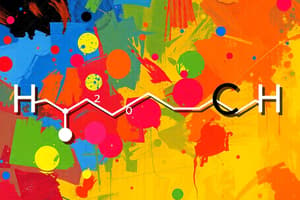Podcast
Questions and Answers
What is the outcome of hydrolyzing esters?
What is the outcome of hydrolyzing esters?
- Conversion into alcohols
- Synthesis of amides
- Production of amines
- Formation of carboxylic acids (correct)
What do amides yield upon hydrolysis?
What do amides yield upon hydrolysis?
- Carboxylic acids and amines (correct)
- Carboxylic acids and alcohols
- Esters and amines
- Alcohols and ketones
Which process is known as saponification?
Which process is known as saponification?
- Hydrolysis of esters in basic solution (correct)
- Conversion of carboxylic acids into esters
- Hydrolysis of esters in acidic solution
- Hydrolysis of amides
Which method is primarily used to reduce amides?
Which method is primarily used to reduce amides?
What is the primary reactant in the hydrolysis of esters?
What is the primary reactant in the hydrolysis of esters?
Which statement is true about ester hydrolysis?
Which statement is true about ester hydrolysis?
What are the products of ester hydrolysis in basic conditions?
What are the products of ester hydrolysis in basic conditions?
When amides are hydrolyzed, what happens to the amino group?
When amides are hydrolyzed, what happens to the amino group?
What is typically required to hydrolyze an amide?
What is typically required to hydrolyze an amide?
In ester hydrolysis, what role does water play?
In ester hydrolysis, what role does water play?
Study Notes
Amines
- Amines are organic derivatives of ammonia, containing a nitrogen atom with a lone pair of electrons, making them both basic and nucleophilic.
- Amines can be classified as primary (1°), secondary (2°), or tertiary (3°) based on the number of alkyl (or aryl) substituents bonded to the nitrogen atom.
Nomenclature of Amines
- Amines with more than one functional group are named by considering the –NH2 as an amino substituent on the parent molecule.
- Amines can be named using the "N-alkyl" term(s) at the beginning of the name.
- Cyclic amides are called lactams.
- Nitriles are named by adding the nitrile suffix to the name of the corresponding alkane.
Properties of Amines
- Amines with fewer than five carbon atoms are generally water-soluble.
- Primary and secondary amines form hydrogen bonds and are highly associated.
- Amines have a distinctive odour, with low-molecular-weight amines having a fishlike aroma.
Substitution of the Hydroxyl Group
- Reactions involving the replacement of the hydroxyl group of a carboxylic acid with another nucleophilic group are important for preparing functional derivatives of carboxylic acids.
Preparation of Amides and Esters
- Acyl halides can be prepared by treating carboxylic acids with thionyl chloride (SOCl2) or phosphorus tribromide (PBr3).
- Acid anhydrides are derived from two molecules of carboxylic acid and amines.
- Amides are usually prepared by reaction of an acid chloride with an amine.
- Esters are prepared by reaction of an acid with an alcohol.
Reactions of Esters and Amides
- Esters undergo hydrolysis to yield carboxylic acids plus alcohols.
- Amides undergo hydrolysis to yield carboxylic acids plus amine on heating in either aqueous acid or aqueous base.
- Amides can also undergo reduction to yield amines.
Studying That Suits You
Use AI to generate personalized quizzes and flashcards to suit your learning preferences.
Related Documents
Description
Understand the chemistry of amines, their properties, and reactions involving substitution of the hydroxyl group in carboxylic acids.




